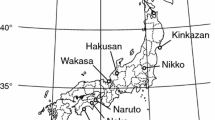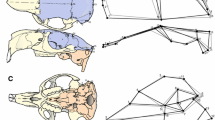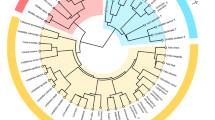Abstract
Understanding the evolutionary significance of morphological diversity is a major goal of evolutionary biology. Paranasal sinuses, which are pneumatized hollow spaces in the face, have attracted attention from researchers as one of the most intriguing traits that show unexpected variations. Macaques are one genus of primates that have accomplished adaptive radiation and therefore present an excellent opportunity to investigate the phenotypic diversification process. Using the large data set of computed tomography images of macaques (172 specimens from 17 species), we applied geometric morphometrics and multivariate analyses to quantitatively evaluate the maxillary sinus (one of the largest paranasal sinuses), the outer craniofacial shape, and nasal cavity. We then applied phylogenetic comparative methods to test their morphological interactions, phylogenetic, and ecogeographical significances. The results showed that the relative maxillary sinus size was significantly associated with the relative nasal cavity size and with the zygomaxillary surface shape. The relative nasal cavity size had ecogeographical correlations and high phylogenetic signal, whereas the zygomaxillary surface shapes were ecogeographically and phylogenetically irrelevant. The significant interactions with multiple surrounding traits that have experienced different evolutionary processes probably enable the maxillary sinus to show enigmatic diversity, which is independent of phylogeny and ecology. The pliable nature of the maxillary sinus, which is positioned between the nasal airways and the outer face, may play a role as a spatial compromise in craniofacial modifications.




Similar content being viewed by others
References
Adams, D. C., & Otárola Castillo, E. (2013). Geomorph: An R package for the collection and analysis of geometric morphometric shape data. Methods in Ecology and Evolution, 4(4), 393–399.
Albrecht, G. H. (1978). The craniofacial morphology of the Sulawesi macaques: Multivariate approaches to biological problems. Contributions to primatology, 13, 1–151.
Allen, W. L., Stevens, M., & Higham, J. P. (2014). Character displacement of Cercopithecini primate visual signals. Nature Communications, 5, 4266.
Andrews, P., & Martin, L. (1987). Cladistic relationships of extant and fossil hominoids. Journal of Human Evolution, 16(1), 101–118.
Antón, S. C. (1996). Cranial adaptation to a high attrition diet in Japanese macaques. International Journal of Primatology, 17(3), 401–427.
Arnold, C., Matthews, L. J., & Nunn, C. L. (2010). The 10 k trees website: A new online resource for primate phylogeny. Evolutionary Anthropology, 19(3), 114–118.
Bastir, M., & Rosas, A. (2013). Cranial airways and the integration between the inner and outer facial skeleton in humans. American Journal of Physical Anthropology, 152(2), 287–293.
Blanton, P. L., & Biggs, N. L. (1969). Eighteen hundred years of controversy: The paranasal sinuses. American Journal of Anatomy, 124(2), 135–147.
Blomberg, S. P., Garland, T, Jr, & Ives, A. R. (2003). Testing for phylogenetic signal in comparative data: behavioral traits are more labile. Evolution, 57(4), 717–745.
Brown, W. L., & Wilson, E. O. (1956). Character displacement. Systematic Zoology, 5(2), 49–64.
Butaric, L. N. (2015). Differential scaling patterns in maxillary sinus volume and nasal cavity breadth among modern humans. Anatomical Record, 298(10), 1710–1721.
Butaric, L. N., McCarthy, R. C., & Broadfield, D. C. (2010). A preliminary 3D computed tomography study of the human maxillary sinus and nasal cavity. American Journal of Physical Anthropology, 143(3), 426–436.
Butler, M. A., & King, A. A. (2004). Phylogenetic comparative analysis: A modeling approach for adaptive evolution. The American Naturalist, 164(6), 683–695.
Canty, A., & Ripley, B. (2015). Ripley B. boot: Bootstrap R (S-Plus) functions. R package version 1.3-17.
Coleman, M. N., & Colbert, M. W. (2007). Technical note: CT thresholding protocols for taking measurements on three dimensional models. American Journal of Physical Anthropology, 133(1), 723–725.
Curtis, A. A., Lai, G., Wei, F., & Valkenburgh, B. (2015). Repeated loss of frontal sinuses in arctoid carnivorans. Journal of Morphology, 276(1), 22–32.
Curtis, A. A., & Van Valkenburgh, B. (2014). Beyond the sniffer: Frontal sinuses in Carnivora. Anatomical Record, 297(11), 2047–2064.
Delson, E. (1980). Fossil macaques, phyletic relationships and a scenario of deployment. In D. G. Lindburg (Ed.), The macaques: Studies in ecology, behavior and evolution (pp. 10–30). New York: Nostrand-Reinhold.
Eudey, A. A. (1980). Pleistocene glacial phenomena and the evolution of Asian macaques. In D. G. Lindburg (Ed.), The macaques: Studies in ecology, behavior and evolution (pp. 52–83). New York: Nostrand Reinhold Ltd.
Fa, J. (1989). The genus Macaca: A review of taxonomy and evolution. Mammal Review, 19(2), 45–81.
Farke, A. A. (2007). Morphology, constraints, and scaling of frontal sinuses in the hartebeest, Alcelaphus buselaphus (Mammalia: Artiodactyla, Bovidae). Journal of Morphology, 268(3), 243–253.
Farke, A. A. (2010). Evolution and functional morphology of the frontal sinuses in Bovidae (Mammalia: Artiodactyla), and implications for the evolution of cranial pneumaticity. Zoological Journal of the Linnean Society, 159(4), 988–1014.
Felsenstein, J. (1985). Phylogenies and the comparative method. The American Naturalist, 125(1), 1–15.
Fleagle, J. G. (2013). Primate adaptation and evolution (3rd ed.). San Diego: Academic Press.
Fooden, J. (1969). Taxonomy and evolution of the monkeys of Celebes. Bibliotheca Primatologica, 10, 1–148.
Fooden, J. (1980). Classification and distribution of living macaques (Macaca Lacépède, 1799). In D. G. Lindburg (Ed.), The Macaques: Studies in ecology, behavior and evolution (pp. 1–9). New York: Van Nostrand Reinhold.
Fooden, J. (1982). Ecogeographic segregation of macaque species. Primates, 23(4), 574–579.
Fooden, J. (1990). The bear macaques, Macaca arctoides: A systematic review. Journal of Human Evolution, 19, 607–686.
Fooden, J. (2000). Systematic review of the rhesus macaques, Macaca mulatta (Zimmermann 1780). Fieldiana Zoology, 96(30), 1–180.
Gebo, D. L., MacLatchy, L., Kityo, R., Deino, A., Kingston, J., & Pilbeam, D. (1997). A hominoid genus from the early Miocene of Uganda. Science, 276(5311), 401–404.
Gunz, P., Mitteroecker, P., & Bookstein, F. L. (2005). Semilandmarks in three dimensions. In D. E. Slice (Ed.), Modern morphometrics in physical anthropology (pp. 73–98). New York: Kluwer Academic Publishers.
Harmon, L. J., Losos, J. B., Jonathan Davies, T., Gillespie, R. G., Gittleman, J. L., Bryan Jennings, W., et al. (2010). Early bursts of body size and shape evolution are rare in comparative data. Evolution, 64(8), 2385–2396.
Harmon, L. J., Weir, J. T., Brock, C. D., Glor, R. E., & Challenger, W. (2008). GEIGER: investigating evolutionary radiations. Bioinformatics, 24(1), 129–131.
Holton, N., Yokley, T., & Butaric, L. (2013). The morphological interaction between the nasal cavity and maxillary sinuses in living humans. Anatomical Record, 296(3), 414–426.
Holton, N. E., Yokley, T. R., Franciscus, R. G., et al. (2011). Climatic adaptation and Neandertal facial evolution: A comment on Rae et al. (2011). Journal of Human Evolution, 61(5), 624–627.
Ito, T., Kawamoto, Y., Hamada, Y., & Nishimura, T. D. (2015a). Maxillary sinus variation in hybrid macaques: implications for the genetic basis of craniofacial pneumatization. Biological Journal of the Linnean Society, 115(2), 333–347.
Ito, T., Nishimura, T. D., Ebbestad, J. O. R., & Takai, M. (2014a). Computed tomography examination of the face of Macaca anderssoni (Early Pleistocene, Henan, northern China): implications for the biogeographic history of Asian macaques. Journal of Human Evolution, 72, 64–80.
Ito, T., Nishimura, T. D., Hamada, Y., & Takai, M. (2015b). Contribution of the maxillary sinus to the modularity and variability of nasal cavity shape in Japanese macaques. Primates, 56(1), 11–19.
Ito, T., Nishimura, T., & Takai, M. (2014b). Ecogeographical and Phylogenetic effects on craniofacial variation in macaques. American Journal of Physical Anthropology, 154(1), 27–41.
Jungers, W. L., Falsetti, A. B., & Wall, C. E. (1995). Shape, relative size, and size-adjustments in morphometrics. American Journal of Physical Anthropology, 38(S21), 137–161.
Kamilar, J. M., & Cooper, N. (2013). Phylogenetic signal in primate behaviour, ecology and life history. Philosophical Transactions of the Royal Society B: Biological Sciences, 368(1618), 20120341.
Keir, J. (2009). Why do we have paranasal sinuses? The Journal of Laryngology & Otology, 123(01), 4–8.
Klingenberg, C. R. (2011). MorphoJ: An integrated software package for geometric morphometrics. Molecular Ecology Resources, 11(2), 353–357.
Koppe, T., Nagai, H., & Rae, T. C. (1999a). The maxillary sinus in primate paleontology and systematics. In T. Koppe, H. Nagai, & K. W. Alt (Eds.), The paranasal sinuses of higher primates: Development, function, and evolution (pp. 177–189). Berlin: Quintessence.
Koppe, T., & Ohkawa, Y. (1999). Pneumatization of the facial skelton in catarrhine primates. In T. Koppe, H. Nagai, & K. W. Alt (Eds.), The paranasal sinuses of higher primates: Development, function, and evolution (pp. 77–119). Berlin: Quintessence.
Koppe, T., Rae, T. C., & Swindler, D. R. (1999b). Influence of craniofacial morphology on primate paranasal pneumatization. Annals of Anatomy, 181(1), 77–80.
Márquez, S. (2008). The paranasal sinuses: The last frontier in craniofacial biology. Anatomical Record, 291(11), 1350–1361.
Márquez, S., & Laitman, J. T. (2008). Climatic effects on the nasal complex: A CT imaging, comparative anatomical, and morphometric investigation of Macaca mulatta and Macaca fascicularis. Anatomical Record, 291(11), 1420–1445.
Márquez, S., Pagano, A. S., Delson, E., Lawson, W., & Laitman, J. T. (2014). The nasal complex of Neanderthals: An entry portal to their place in human ancestry. Anatomical Record, 297(11), 2121–2137.
Mori, F., Hanida, S., Kumahata, K., Miyabe-Nishiwaki, T., Suzuki, J., Matsuzawa, T., et al. (2015). Minor contributions of the maxillary sinus to the air-conditioning performance in macaque monkeys. Journal of Experimental Biology, 218, 2394–2401.
Münkemüller, T., Lavergne, S., Bzeznik, B., Dray, S., Jombart, T., Schiffers, K., et al. (2012). How to measure and test phylogenetic signal. Methods in Ecology and Evolution, 3(4), 743–756.
Neeser, R., Ackermann, R. R., & Gain, J. (2009). Comparing the accuracy and precision of three techniques used for estimating missing landmarks when reconstructing fossil hominin crania. American Journal of Physical Anthropology, 140(1), 1–18.
Nishimura, T. D., & Ito, T. (2014). Aplasia of the maxillary sinus in a Tibetan macaque (Macaca thibetana) with implications for its evolutionary loss and reacquisition. Primates, 55(4), 501–508.
Nishimura, T. D., Ito, T., Yano, W., Ebbestad, J. O. R., & Takai, M. (2014). Nasal architecture in Procynocephalus wimani (Early Pleistocene, China) and implications for its phyletic relationship with Paradolichopithecus. Anthropological Science, 122(2), 101–113.
Nishimura, T. D., Senut, B., Prieur, A., Treil, J., & Takai, M. (2009). Nasal architecture of Paradolichopithecus arvernensis (late Pliocene, Seneze, France) and its phyletic implications. Journal of Human Evolution, 56, 213–217.
Nishimura, T. D., Takai, M., & Maschenko, E. N. (2007). The maxillary sinus of Paradolichopithecus sushkini (late Pliocene, southern Tajikistan) and its phyletic implications. Journal of Human Evolution, 52(6), 637–646.
Nishimura, T. D., Takai, M., Tsubamoto, T., Egi, N., & Shigehara, N. (2005). Variation in maxillary sinus anatomy among platyrrhine monkeys. Journal of Human Evolution, 49(3), 370–389.
Noback, M. L., Harvati, K., & Spoor, F. (2011). Climate-related variation of the human nasal cavity. American Journal of Physical Anthropology, 145(4), 599–614.
O’Higgins, P., Bastir, M., & Kupczik, K. (2006). Shaping the human face. International Congress Series, 1296, 55–73.
Orme, D., Franckleton, R., Thomas, G., Petzoldt, T., Fritz, S., Isaac, N., et al. (2013). Caper: Comparative analyses of phylogenetics and evolution in R. R package version 0.5.2.
Pagel, M. (1999). Inferring the historical patterns of biological evolution. Nature, 401(6756), 877–884.
Pan, R., & Oxnard, C. E. (2002). Craniodental variation among Macaques (Macaca), nonhuman primates. BMC Evolutionary Biology, 2, 1–12.
Pennell, M. W., & Harmon, L. J. (2013). An integrative view of phylogenetic comparative methods: Connections to population genetics, community ecology, and paleobiology. Annals of the New York Academy of Sciences, 1289(1), 90–105.
Pérez de los Ríos, M., Moyà-Solà, S., & Alba, D. M. (2012). The nasal and paranasal architecture of the Middle Miocene ape Pierolapithecus catalaunicus (Primates: Hominidae): Phylogenetic implications. Journal of Human Evolution, 63(3), 497–506.
Polly, P. D., Lawing, A. M., Fabre, A.-C., & Goswami, A. (2013). Phylogenetic principal components analysis and geometric morphometrics. Hystrix, the Italian Journal of Mammalogy, 24(1), 33–41.
Racicot, R. A., & Berta, A. (2013). Comparative morphology of porpoise (Cetacea: Phocoenidae) pterygoid sinuses: Phylogenetic and functional implications. Journal of Morphology, 274(1), 49–62.
Rae, T. C. (2008). Paranasal pneumatization in extant and fossil Cercopithecoidea. Journal of Human Evolution, 54(3), 279–286.
Rae, T. C., Hill, R. A., Hamada, Y., & Koppe, T. (2003). Clinical variation of sinus volume in Japanese macaques (Macaca fuscata). American Journal of Primatology, 59(4), 153–158.
Rae, T. C., & Koppe, T. (2000). Isometric scaling of maxillary sinus volume in hominoids. Journal of Human Evolution, 38(3), 411–423.
Rae, T. C., & Koppe, T. (2004). Holes in the head: Evolutionary interpretations of the paranasal sinuses in catarrhines. Evolutionary Anthropology, 13(6), 211–223.
Rae, T. C., & Koppe, T. (2008). Independence of biomechanical forces and craniofacial pneumatization in Cebus. Anatomical Record, 291(11), 1414–1419.
Rae, T. C., & Koppe, T. (2014). Sinuses and flotation: Does the aquatic ape theory hold water? Evolutionary Anthropology, 23(2), 60–64.
Rae, T. C., Koppe, T., & Nagai, H. (1997). Maxillary sinus reduction due to cold stress in the Macaca fascisularis species group. American Journal of Physical Anthropology, Suppliment, 24, 190–191.
Rae, T. C., Koppe, T., Spoor, F., Benefit, B., & McCrossin, M. (2002). Ancestral loss of the maxillary sinus in old world monkeys and independent acquisition in Macaca. American Journal of Physical Anthropology, 117(4), 293–296.
Rae, T. C., Koppe, T., & Stringer, C. B. (2011a). The Neanderthal face is not cold adapted. Journal of Human Evolution, 60(2), 234–239.
Rae, T. C., Koppe, T., Stringer, C. B., et al. (2011b). Hyperpneumatized Neanderthals? Reply to Holton et al. (2011). Journal of Human Evolution, 61(5), 628–629.
Rae, T. C., Vidarsdottir, U. S., Jeffery, N., & Steegmann, A. T. (2006). Developmental response to cold stress in cranial morphology of Rattus: implications for the interpretation of climatic adaptation in fossil hominins. Proceedings of the Royal Society B: Biological Sciences, 273(1601), 2605–2610.
R Core Team. 2015. R: A language and environment for statistical computing. Vienna: R Foundation for Statistical Computing.
Revell, L. J. (2009). Size correction and principal components for interspecific comparative studies. Evolution, 63(12), 3258–3268.
Revell, L. J. (2012). Phytools: An R package for phylogenetic comparative biology (and other things). Methods in Ecology and Evolution, 3(2), 217–223.
Rohlf, F. J. (2001). Comparative methods for the analysis of continuous variables: Geometric interpretations. Evolution, 55(11), 2143–2160.
Rossie, J. B. (2008). The phylogenetic significance of anthropoid paranasal sinuses. Anatomical Record, 291(11), 1485–1498.
Rossie, J. B., Simons, E. L., Gauld, S. C., & Rasmussen, D. T. (2002). Paranasal sinus anatomy of Aegyptopithecus: implications for hominoid origins. Proceedings of the National Academy of Sciences of the United States of America, 99(2), 8454–8456.
Santana, S. E., Alfaro, J. L., & Alfaro, M. E. (2012). Adaptive evolution of facial colour patterns in Neotropical primates. Proceedings of the Royal Society B: Biological Sciences, 279(1736), 2204–2211.
Santana, S. E., Alfaro, J. L., Noonan, A., & Alfaro, M. E. (2013). Adaptive response to sociality and ecology drives the diversification of facial colour patterns in catarrhines. Nature Communications, 4, 2765.
Santana, S. E., Dobson, S. D., & Diogo, R. (2014). Plain faces are more expressive: Comparative study of facial colour, mobility and musculature in primates. Biology Letters, 10(5), 20140275.
Schlager, S. (2015). Morpho: Calculations and visualisations related to Geometric Morphometrics. R package version 2.3.0.
Shea, B. T. (1977). Eskimo craniofacial morphology, cold stress and the maxillary sinus. American Journal of Physical Anthropology, 47(2), 289–300.
Smith, R. J. (1984). Determination of relative size: The “criterion of subtraction” problem in allometry. Journal of Theoretical Biology, 108(1), 131–142.
Smith, T. D., Rossie, J. B., Cooper, G. M., Carmody, K. A., Schmieg, R. M., Bonar, C. J., et al. (2010). The maxillary sinus in three genera of new world monkeys: Factors that constrain secondary pneumatization. Anatomical Record, 293(1), 91–107.
Smith, T. D., Rossie, J. B., Cooper, G. M., Schmieg, R. M., Bonar, C. J., Mooney, M. P., et al. (2011). Comparative microcomputed tomography and histological study of maxillary pneumatization in four species of new world monkeys: the perinatal period. American Journal of Physical Anthropology, 144(3), 392–410.
Takahashi, L. K., & Pan, R. (1994). Mandibular morphometrics among macaques: The case of Macaca thibetana. International Journal of Primatology, 15(4), 597–621.
Takai, M., Maschenko, E. N., Nishimura, T. D., Anezaki, T., & Suzuki, T. (2008). Phylogenetic relationships and biogeographic history of Paradolichopithecus suskini Trofimov 1977, a large-bodied cercopithecus monkey from the Pliocene of Eurasia. Quaternary International, 179(1), 108–119.
Warton, D. I., Duursma, R. A., Falster, D. S., & Taskinen, S. (2012). Smatr 3–an R package for estimation and inference about allometric lines. Methods in Ecology and Evolution, 3(2), 257–259.
Witmer, L. M. (1997). The evolution of the antorbital cavity of Archosaurs: A study in soft-tissue reconstruction in the fossil record with an analysis of the function of pneumaticity. Journal of Vertebrate Paleontology, 17(1), 1–73.
Witmer, L. M. (1999). The phylogenetic history of the paranasal air sinuses. In T. Koppe, H. Nagai, & K. W. Alt (Eds.), The paranasal sinuses of higher primates (pp. 21–34). Berlin: Quintessence.
Witmer, L. M., & Ridgely, R. C. (2008). The paranasal air sinuses of predatory and armored dinosaurs (Archosauria: Theropoda and Ankylosauria) and their contribution to cephalic structure. Anatomical Record, 291(11), 1362–1388.
Yokley, T. R. (2009). Ecogeographic variation in human nasal passages. American Journal of Physical Anthropology, 138(1), 11–22.
Zollikofer, C. P. E., De Leon, M. S. P., Schmitz, R. W., & Stringer, C. B. (2008). New insights into Mid-Late Pleistocene fossil hominin paranasal sinus morphology. Anatomical Record, 291(11), 1506–1516.
Acknowledgments
We thank D. Shimizu, T. Takano, Y. Shintaku, H. Taru, H. Hirotani, H. Takahashi, and N. Shigehara for kindly providing access to the specimens; and S. Kondo, N. Ogihara, M. Nakatsukasa, W. Yano, Thaung Htike, and Zin-Maung-Maung-Thein for their help with CT scanning. We also thank B. Hallgrimsson, C. Rolian, and two anonymous reviewers for their constructive comments that significantly improved our manuscript. This study was funded by JSPS Grants-in-Aid for Scientific Research (Grant 26650171 to T.D.N.; Grant 26304019 to M. Takai).
Author information
Authors and Affiliations
Corresponding author
Ethics declarations
Conflict of Interest
The authors declare that they have no conflict of interest.
Electronic supplementary material
Below is the link to the electronic supplementary material.
Rights and permissions
About this article
Cite this article
Ito, T., Nishimura, T.D. Enigmatic Diversity of the Maxillary Sinus in Macaques and Its Possible Role as a Spatial Compromise in Craniofacial Modifications. Evol Biol 43, 414–426 (2016). https://doi.org/10.1007/s11692-016-9369-4
Received:
Accepted:
Published:
Issue Date:
DOI: https://doi.org/10.1007/s11692-016-9369-4




